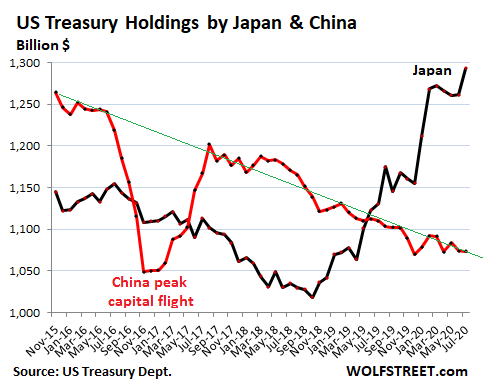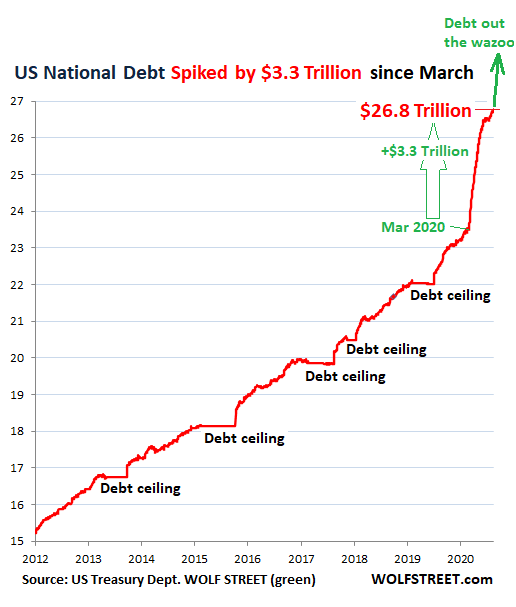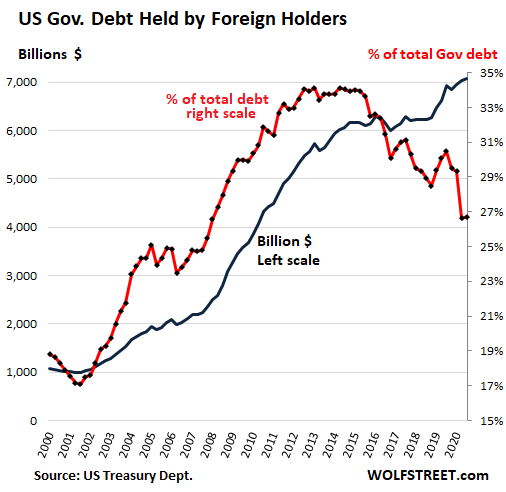Who Bought the $3.3 Trillion Piled on the Incredibly Spiking US National Debt Since March?
by Wolf Richter, Wolf Street:
 Trillions flying by so fast, it’s hard to even count them. But somebody had to buy these Treasury securities. And it wasn’t just the Fed. Here’s who.
Trillions flying by so fast, it’s hard to even count them. But somebody had to buy these Treasury securities. And it wasn’t just the Fed. Here’s who.
In the 12 months through February, before the Pandemic started – those were the Good Times when a government shouldn’t have to borrow heavily – the US government added a breath-taking $1.4 trillion to its already huge pile of debt. And then came the Pandemic and the bailouts and the stimulus payments and all the other stuff, and over the six months since then, the US government added another $3.3 trillion to the Incredibly Spiking US Gross National Debt that now amounts to $26.8 trillion:

With the release yesterday afternoon of the Treasury Department’s Treasury International Capital data through July 31, Fed balance sheet data, bank balance sheet data from the Federal Reserve, and the Treasury Department’s data on Treasury securities, we can sort out who bought those trillions of dollars in Treasury Securities over the past 12 months.
Foreign investors:
Foreign investors all combined – central banks, government entities, companies, commercial banks, bond funds, other funds, and individuals – added $287 billion to their holdings in July compared to July last year, including $48 billion during the month of July. This brought their holdings to a record of $7.087 trillion (blue line, right scale in the chart below).
But due to the Incredibly Spiking US National Debt ($26.5 trillion on July 31), their share of this debt (red line, right scale), after plunging in June to the lowest since 2008, only held steady in July, at 26.7%:

America’s biggest foreign creditors, Japan and China: Japan increased its holdings in July by $32 billion, to a total of $1.29 trillion. Over the 12 months, its holdings increased by $162 billion.
China whittled down its holdings further in July. Over the 12-month period, its holdings fell by $37 billion, to $1.07 trillion, following the trend (green line) since 2015, with exception of the plunge and recovery around its capital-flight phase.
Combined, Japan and China held 8.9% of the Incredibly Spiking US debt, the second-lowest share in many years, with the lowest having been in June (8.8%):

The next 10 largest foreign holders (in parenthesis their holdings as of July 2019):
- UK (“City of London” financial center): $425 billion ($406 billion)
- Ireland: $330 billion ($257 billion)
- Hong Kong: $267 billion ($235 billion)
- Brazil: $265 billion ($309 billion)
- Luxembourg: $265 billion ($229 billion)
- Switzerland: $251 billion ($228 billion)
- Cayman Islands: $213 billion ($233 billion)
- Belgium: $211 billion ($203 billion)
- Taiwan: $210 billion ($179 billion)
- India: $195 billion ($160 billion)
This list is studded with tax havens and financial centers, including those where US corporations have mailbox entities that hold assets in an effort to dodge US taxes. So some of these “foreign” holders are US entities, such as Apple in Ireland, with accounts registered in their mailbox operations there.
Missing from this list are Germany and Mexico, which hold only $78 billion and $48 billion respectively in Treasuries, despite their mega-trade surpluses with the US.



